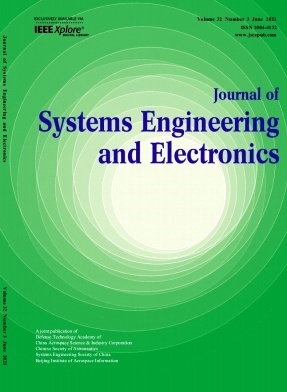Journal of Systems Engineering and Electronics杂志投稿须知:Aims and scopeThe journal, keeping abreast with the development trend of science and technology worldwide, reports the latest developments and achievements in systems engineering and electronics and related research areas, and encourages various academic views. The journal welcomes papers from a wide variety of countries.The journal strives to publish high-quality papers reporting original work in both theoretical and practical research results within the journal scope, involving system analysis, system modeling and simulation, military system analysis, aircraft control, C3I, radar, information systems engineering, machine intelligence, artificial neural networks, information acquisition and processing, aerospace electronics, and other topics in all related fields.TitleThe title is centered on the page and should be short and concise. Please limit the title to a maximum length of 10 words. The author’s name follows and is also centered on the page. The author’s last name should be preceded by the other names spelled out in full. The author’s affiliation and address are also needed.The corresponding author should be clearly indicated with the asterisk (i.e., *) and given on the bottom of the first page. Please provide the financial support acknowledgments (name and number) on the bottom of the first page.AbstractAn abstract, not exceeding 200 words, is required for all papers. Acronyms and abbreviations are spelled out at first mention in the abstract. It should be a summary of the paper and not an introduction. Because the abstract may be used in abstracting journals, it should present concisely the purposes, methodology used, results obtained, and conclusions.KeywordsThe author must provide a list of keywords, up to a maximum of six. No acronyms and abbreviations should be used.TextText should be typed in double-column. The introduction of paper should explain the nature of the problem, previous work, purpose, and contribution of the paper. It is assigned the number “1” and following sections are assigned number as needed. For example, the third section of a paper might be “3. Simulation results” headings. Acronyms and abbreviations are spelled out at first mention in the text, even they have already been defined in the abstract.Figures and tablesThe authors must ensure figures of sufficient quality and resolution. Figure captions appear below the figures. Figures should be numbered in the order they appear in the text. Table titles appear above the tables. Please verify that the figures and tables you mention in the text actually exist. When referring to a figure or a table in the text, use the abbreviation “Fig.” even at the beginning of a sentence, and do not abbreviate “Table”.EquationsNumber equations consecutively with equation numbers in parentheses flush with the right margin, as in (1). Be sure that the symbols in the equation have been defined before the equation appears or immediately following. When referring to “(1)”, do not use “Eq. (1)” or “equation (1),” except at the beginning of a sentence: “Equation (1) is ...”.ConclusionA conclusion must be included and should indicate clearly the advantages, limitations, and possible applications of the paper.AcknowledgmentIndividuals or units other than authors who were of direct help in the work should be acknowledged by a brief statement following the conclusion. This heading is not assigned a number.ReferencesOnly articles that have been published may be included in the references. Each reference is referred to in the text by a number enclosed in a square bracket (i.e., [3]). References must be numbered and ordered according to where they are first mentioned in the paper. A reference list must be included using the following information as a guide.BiographiesShort biographies (120-150 words) should be provided that detail the authors’ education, work histories and research interests as well as their E-mail. The authors’ full names are needed. Small (2.5 cm×3.5 cm), black-and-white and high- resolution (300 dpi) photos of each author should be included.
联系方式
- 投稿邮箱:tougaoxinxiang@263.net
- 联系电话:010-68388406
- 杂志社地址:北京142信箱32分箱
Journal of Systems Engineering and Electronics数据分析
影响因子:指该期刊近两年文献的平均被引用率,即该期刊前两年论文在评价当年每篇论文被引用的平均次数
被引半衰期:衡量期刊老化速度快慢的一种指标,指某一期刊论文在某年被引用的全部次数中,较新的一半被引论文刊载的时间跨度
他引率:期刊被他刊引用的次数占该刊总被引次数的比例用以测度某期刊学术交流的广度、专业面的宽窄以及学科的交叉程度
引用半衰期:指某种期刊在某年中所引用的全部参考文献中较新的一半是在最近多少年时段内刊载的
平均引文数:在给定的时间内,期刊篇均参考文献量,用以测度期刊的平均引文水平,考察期刊吸收信息的能力以及科学交流程度的高低
热门评论
端木*** :
精炼,比起看很多参考书能抓住重点。不过还要通过参考书目上的书来补充部分内容。
席*** :
质量很好,感觉现在这个杂志对录用稿件要求越来越高了,曾有幸在这个期刊上发表一篇,现在努力再发表几篇,很具不错。值得大家投稿。尤其是在投稿网投稿。
令狐*** :
杂志封面精美,内容实用,总的来说很好看,主要是便宜、方便嘛。一本很全面的学术杂志,物超所值。投稿网后期服务也很棒。
夹谷*** :
6月7号投稿,一周后变为审稿费已付,大约又一周后变为选择审稿人,在之后没几天变成等待主编终审,一直持续到今天,打电话问,说大多学校在放假,让等等·········7月27号,又变成等待选择审稿人了·········好吧,我承认我疯了,等待主编终审和等待选择审稿人之间来回变,同一天。
羊舌*** :
从投稿过程来看,Journal of Systems Engineering and Electronics对稿件的创新性有一定要求,专家提的意见很有意义。另外编辑部的工作效率很高,老师态度非常好,这一点非常值得称赞。
尹*** :
Journal of Systems Engineering and Electronics杂志审稿速度还是比较快的。一审l两个星期左右两个审稿意见就出来了(大修)。后来根据要求进行了认真修改,半个月后修回提交。接下来半个月内一直为提交状态,又经过半个月左右接受。前后共两个月。
达奚*** :
审稿速度还可以,编辑非常严谨,规范要求蛮高的,就是费用贵了,一般一篇文章3版,发票7%还要自己出钱,有点猛啊
尉迟*** :
收稿日期:-7-19 修订日期:-8-8,刊物质量高、要求严格,编辑认真负责、效率很高,7月份投的稿,8月底交版面费。
长孙*** :
我投的时候是两个审稿人,6周左右收到了审稿人给的意见,很一针见血,指出了我和老板在投稿之前就认为可能存在的问题。在按照要求修改意见之后,四天内编辑给出的接收意见。
红*** :
6月13日投了这个杂志,7月14日给的外审意见,我觉得Journal of Systems Engineering and Electronics杂志编辑的态度还不错,电话通知让修改,并详细说明了如何修改,8月23日提交修改稿,9月9日变为终审中,9月16日变为已录用。编辑部效率很快,赞!
